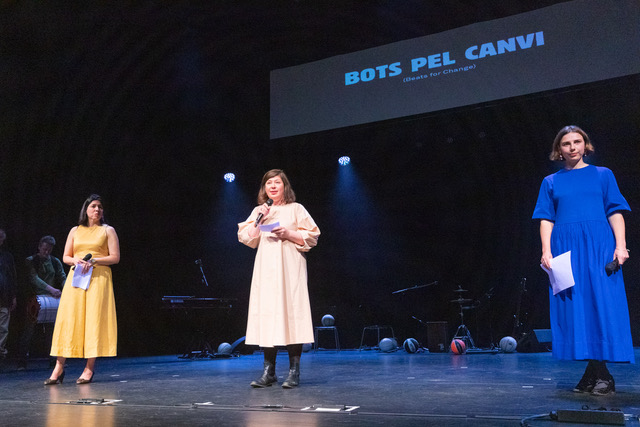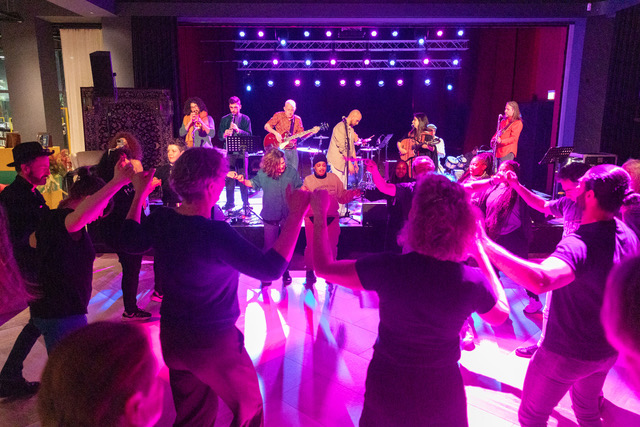Blog 2 Opening evening March 29, 2023
If you have ever played a part in creating a theatre production, you will know that it’s always a challenge to work out just how your show should start. In those opening moments, what can the performers do that will artfully draw a multitude of individual spectators into feeling that they are now an audience with a living, breathing, shared focus toward what is about to unfold on stage? Tonight, we were in the expert hands of Jo Zanders and Luc Mishalle, co-founders of the community music organization Met-X from Brussels, Belgium. This year’s festival resident artists, they know well how hearing sound—in this case the music of a single tootling soprano saxophone accompanied by the rhythm of a single beating drum—can almost instantly weave together a sea of people into a blended, attentive collective. Playing their instruments, the musicians wended their way from outside of the auditorium in through the side door and up on to the boards. The sound met us all where we sat and carried us together into the evening. Like the children in The Pied Piper of Hamelin, we gleefully embraced the sound and followed them as complicit co-creators of the event.
How perfectly this opening embodied the theme and discipline of focus of this year’s festival. Standing side by side on stage, the three core programmers of ICAF 2023, Jasmina, Anamaria, and Amy spoke about taking stock of what we have all come through since 2020, and what we might consider bringing with us as we take our learning into the future. Amy so beautifully characterized the questions they have posed and the framework of the festival, that her words deserve to be relayed here as she offered them:
“Many people working in community arts in very different contexts around the globe share the belief that inclusive, participatory arts can contribute to positive change and transformation in the world. These projects and practices aid us in understanding how we form and share knowledge, build bridges, cross borders, and dig for layers of experience, meaning and perspective beyond our own. Yet this is an ongoing journey of evolution and transition that is not always linear or predictable in its route, and even more so with such global transformations occurring around us.
ICAF 2023 therefore endeavours to explore through the diverse community arts practices and performances we will showcase, how such a complex journey of transition can be encapsulated through the medium of sound.
Sound, for us, requires us to give equal importance to the listener as to the speaker. Sound is a communicator, a way of empathising, sharing, and expressing: a song, a protest, a chant, or complete (but therefore no less meaningful) silence.
Through its many, diverse forms, sound offers us the option to whisper or to shout, to activate our voices and tell our stories, and make space through silence for those who are not heard, as we embark upon our journeys of evolution and transition, towards positive change – the sound of change.”
Koh Hui Ling, Co-Artistic Director (with Han Xuemei) of Drama Box in Singapore was then invited on stage by Anamaria. During the pandemic, Drama Box became ICAF’s first ever international Hub partner, initiating what will continue to grow into a global network of eyes and ears, so that community artists around the world can better see each other and hear each other. Hui Ling spoke literally of what it means to do heart-felt work. She said that as humans, whether we have the ability to hear with our ears or not, we all know the “sound” of our own heartbeats. That heartbeat rhythm pounding in our chests may be quickened by feelings of hope just as it may be quickened by feelings of fear. In either instance, she suggested, the sound of our hearts beating is aliveness itself.
Following Hui Ling, Jasmina next invited to the stage Mr. Said Kasmi, Vice Mayor for Culture in Rotterdam. He addressed, among other things, the impact of polarization and exclusion. He held up faith in the power of arts to counter these forces, to bring people together to repair and to build. As I have begun to consider all of these visionary ideas through the framework of sounds and silences tonight, I find myself thinking about madrigals. Those complex musical constructions rely not on all voices singing in unison, but instead on a polyphony of voices, each voice contributing its offering to the beauty of the whole. A madrigal is held together by its diversity and if even a single part were to fall away, the entire piece would collapse.
Reflecting on our theme and focus, I also found myself revisiting my own sense of what it means to say that community arts is rooted in promoting positive change. Well, of course the push toward creating a more just world with equity, dignity, and freedom is our obvious aspiration. But even on a more basic level, isn’t change enfolded into what makes us human? I listen, and in my thoughts, I hear the words of the great Uruguayan writer Eduardo Galeano ringing in my ears:
Turn loose the voices, undream the dreams. […] What it all comes down to is that we are the sum of our efforts to change who we are. Identity is no museum piece sitting stock-still in a display case, but rather the endlessly astonishing synthesis of the contradictions of everyday life. [from The Book of Embraces].
To be human is to seek change, in ourselves, in our communities, and in our world. At this year’s festival, we are being invited to reflect on how that happens through sound.
The mainstage performance on this first evening was Basket Beat, a participatory music project from Barcelona. In the week leading up to the festival they have been partnering with young people and youth workers of Urban Skillsz from Rotterdam and a group of young people from Rotterdams Wijktheater, who will now join them during various points in the performance.
Tonight, they have fashioned what they do so well into a show. It would be a fool’s errand to try to describe what we saw, heard, and felt. The words “you had to be there” comes to mind. What I can share is that Basket Beat embodies what the performers hope to convey—that peace is not a passive, placid state—it is active. One can, and perhaps should, “wage peace.” What does waging peace look like, sound like, and feel like? For one, they demonstrated how the impulse to meet across lines of difference does not have to manifest as conflict or the arrogance of each side/person to think they are the top dog. We saw them enact how that looks—everyone on stage working at cross purposes, jockeying for all the attention, or maneuvering to get others to do it their way. And we saw the alternative—bouncing their basketballs in rhythm with each other. some among them established a base 4/4 beat and then others found the syncopation, bouncing their basketballs between the baseline beats.
It was unmistakably clear that the whole enterprise only worked because the bouncers were listening to each other’s sounds and rhythms. Each performer brought their own distinct spin to what they were doing (sometimes literally spinning their ball), and so each bouncing ball had its own distinct “voice” and yet it was the engagement between the voices that was utterly joyful to witness and to hear. Perhaps it was only that I was sitting close to the stage, but I could feel the reverberation in my own chest as the balls bounced off the floor. This is the power of performance. They didn’t convince us with dialogue of speeches (apart from some passionately worded lyrics in their songs), they embodied the meaning in their actions. As Francis of Assisi once encouraged his followers: “Always preach the gospel. If necessary, use words.”
For me, it called to mind the spirit behind the Agon in ancient Greece. For the Greeks of that time, athletic competitions were not about beating their opponents in the sense that we think of winning today. The Agon was the arena where the athletes from one region could engage with their counterparts from elsewhere and the great fun and satisfaction of it all was that they got to play with someone as skilled as they were. Basket Beat brought us into that world. They closed with their rallying cry, “Let rhythm be our anthem.” They show us that this is a way we humans can choose to be in our world.



